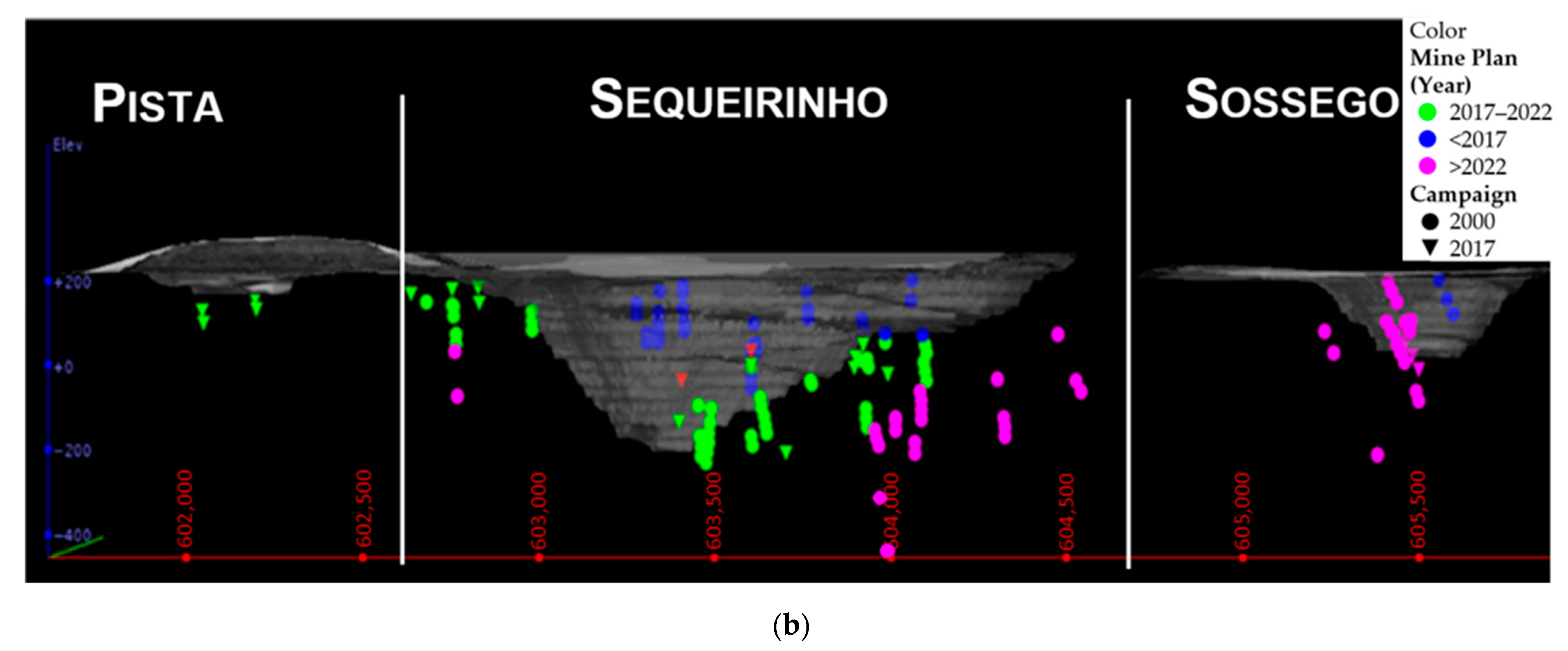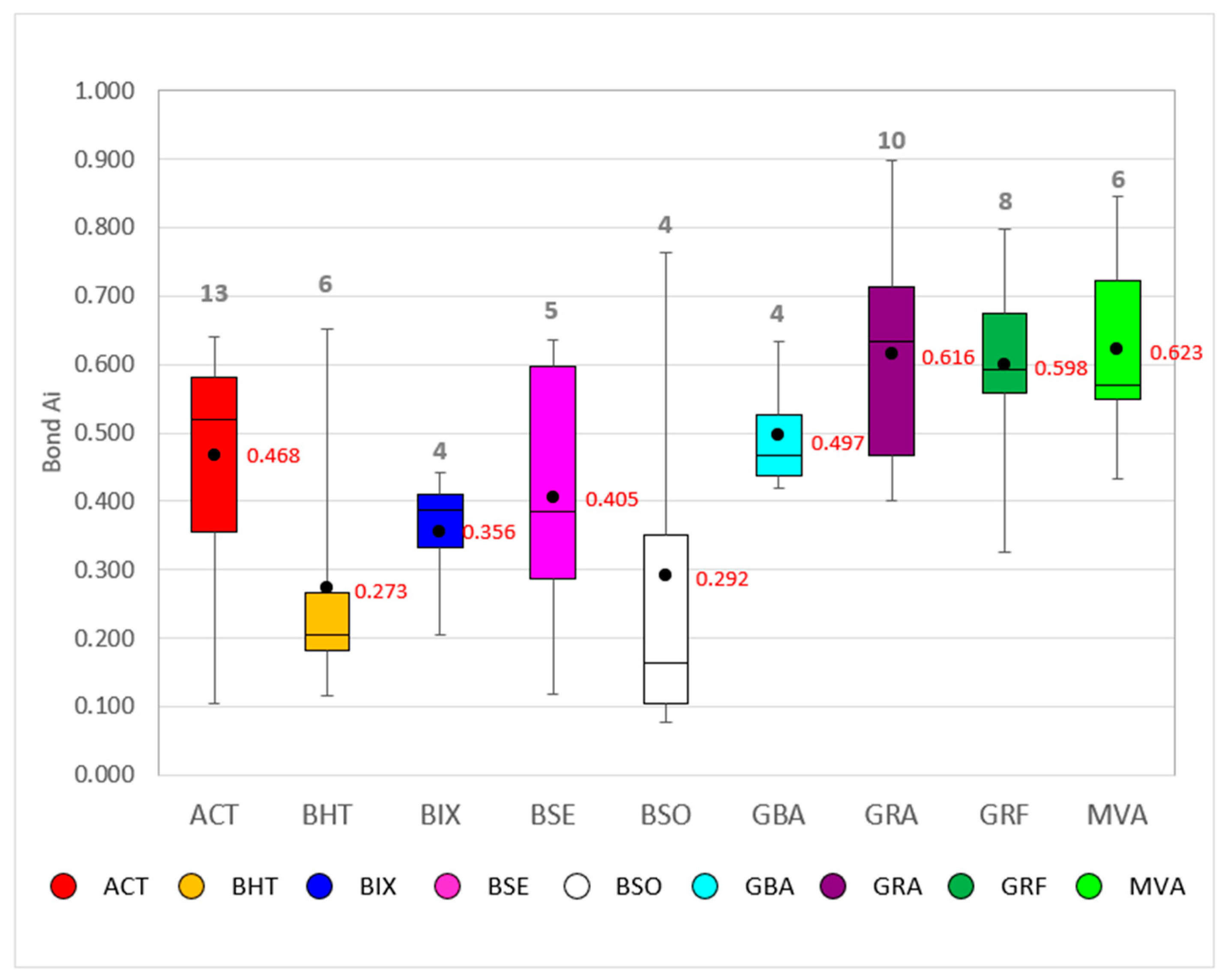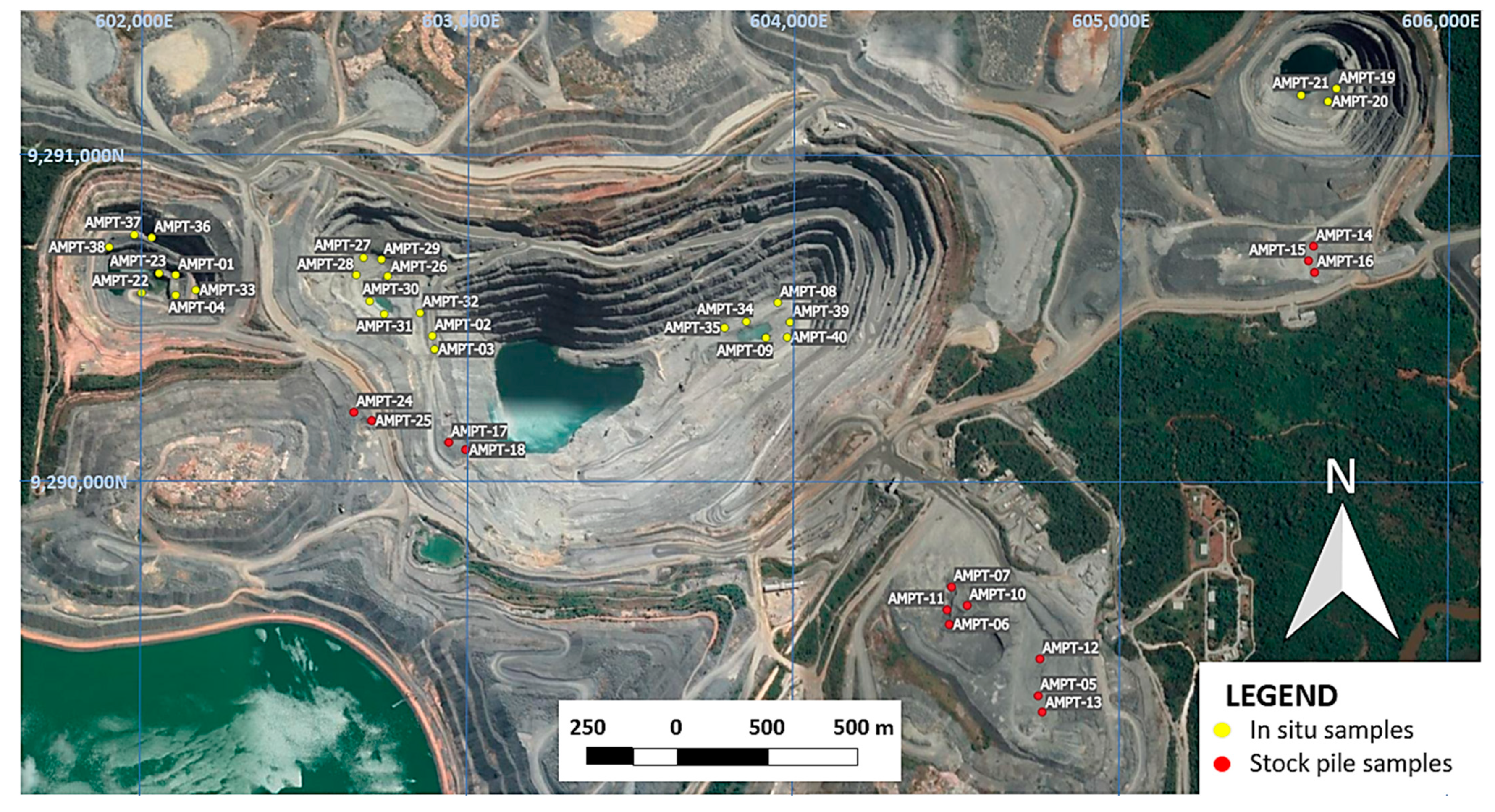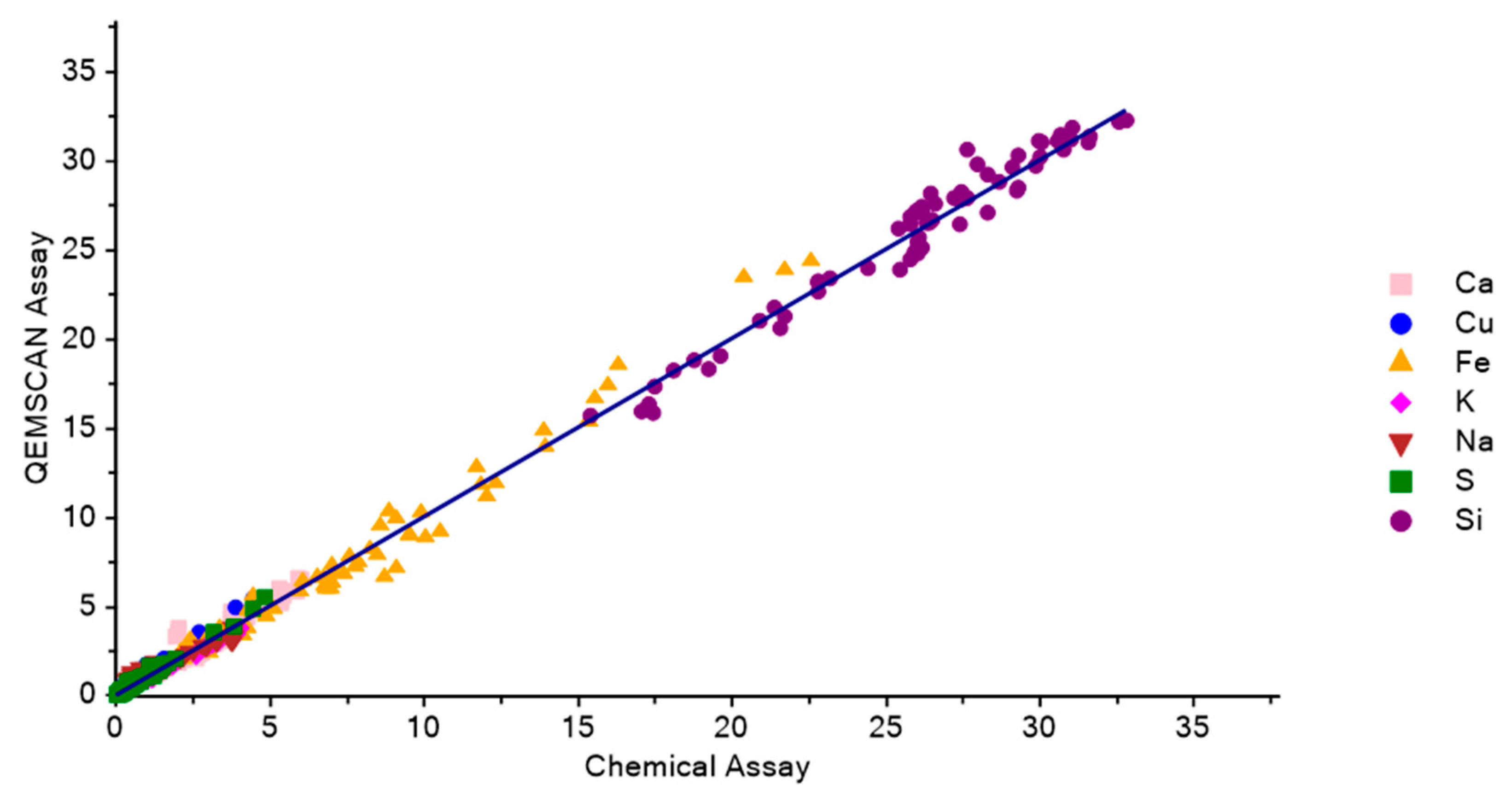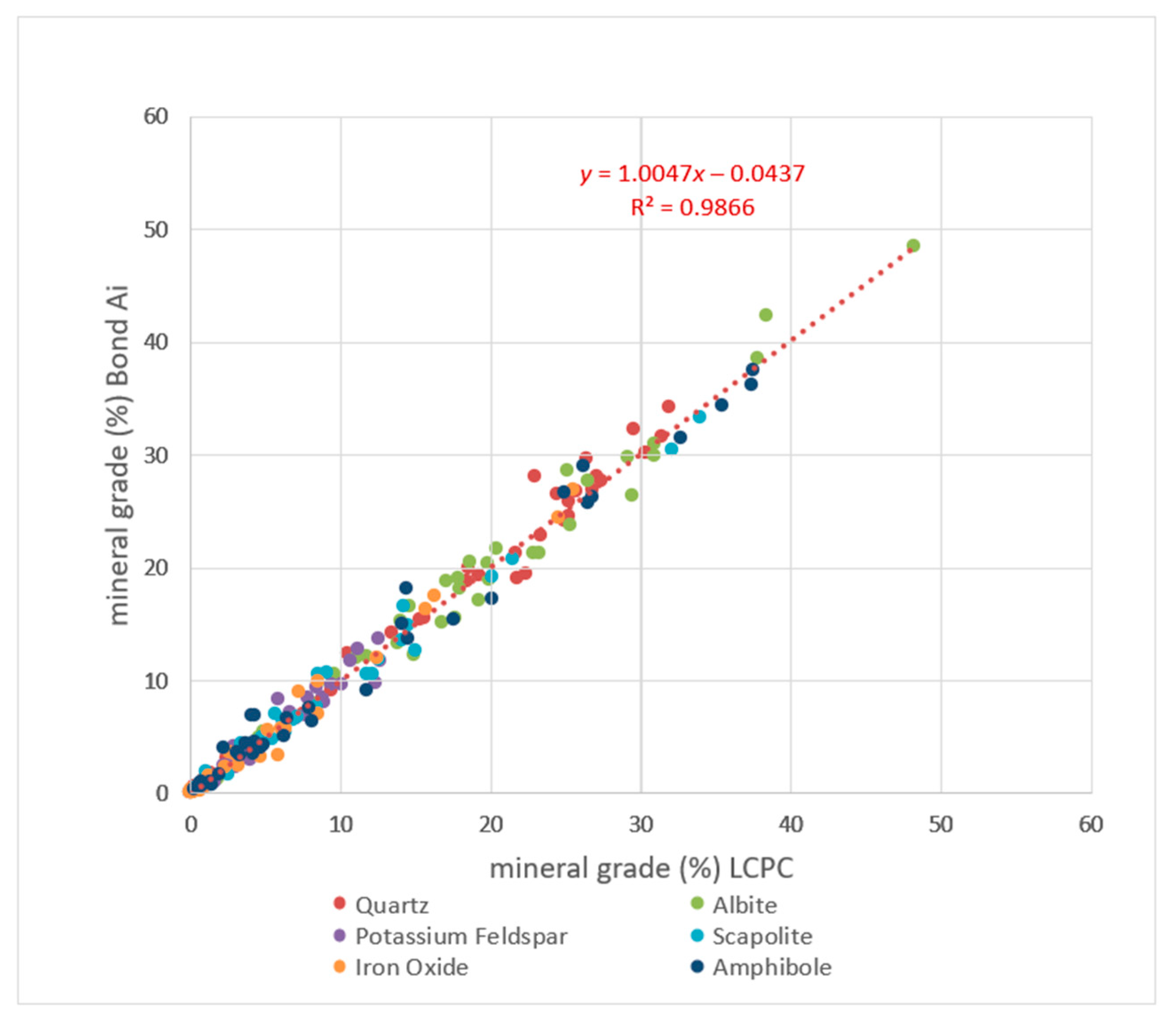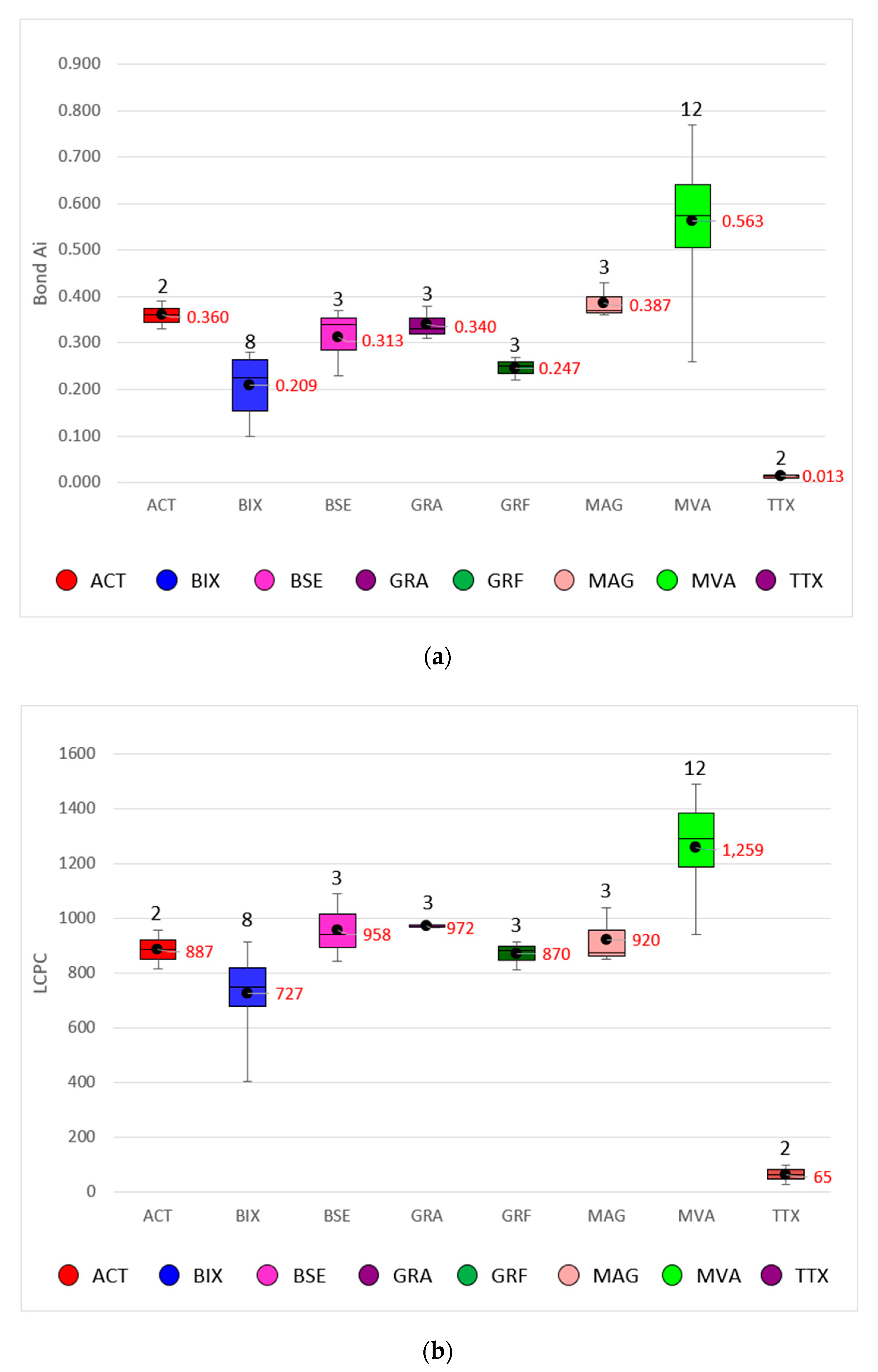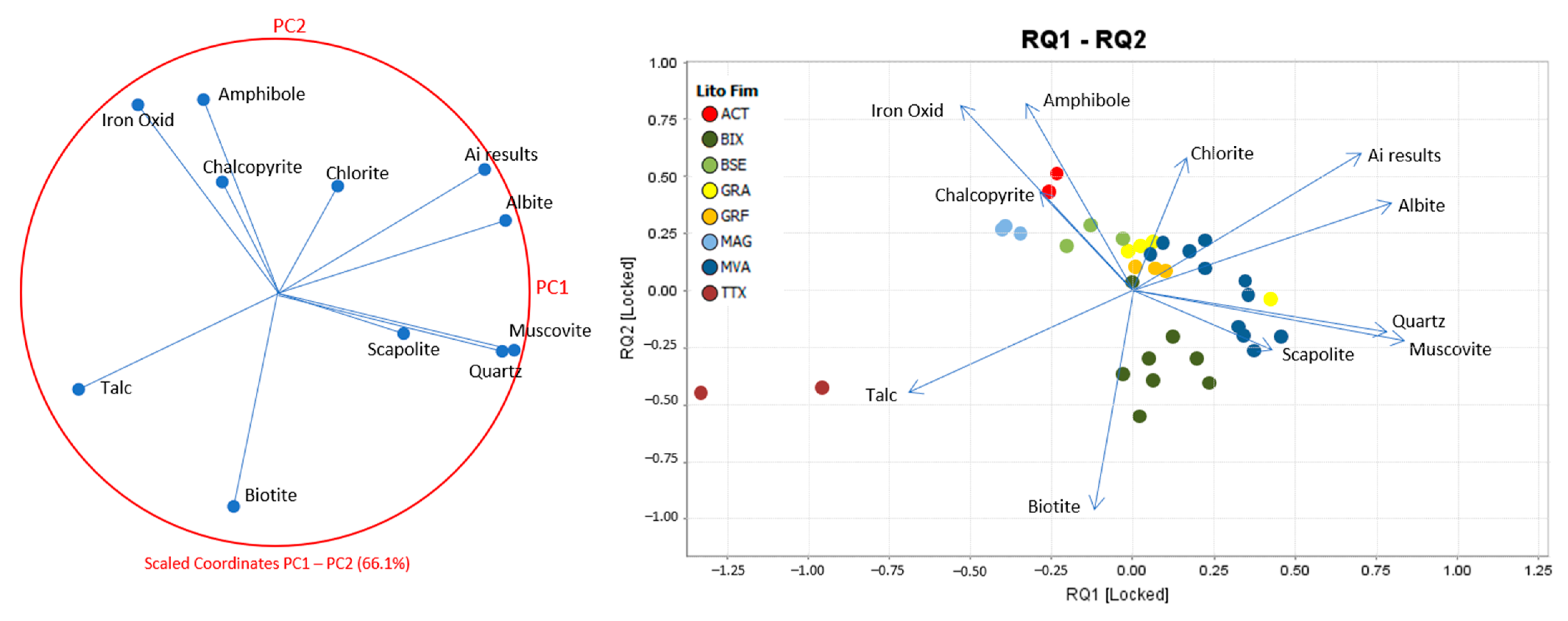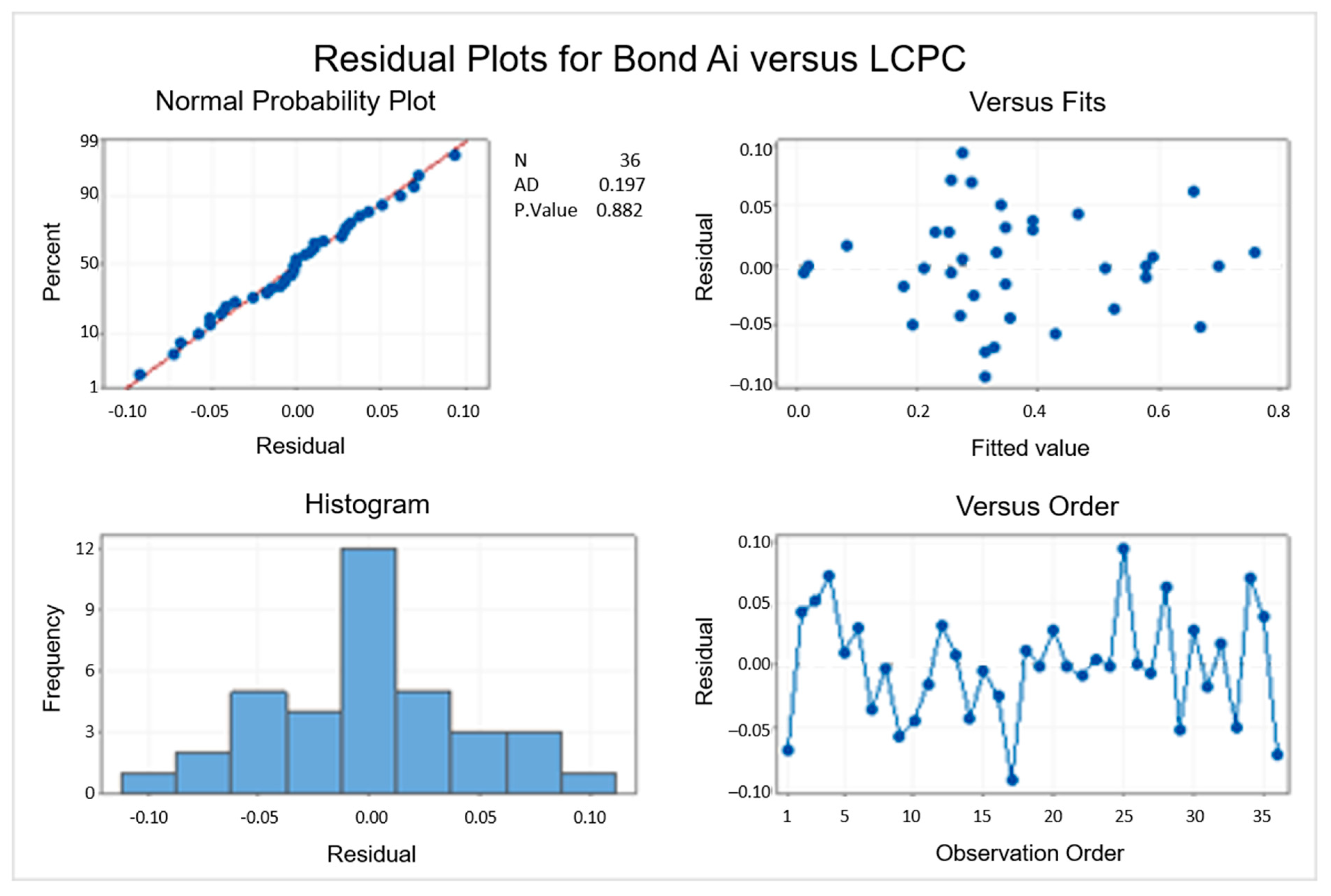1. Introduction
Abrasion is the most common wear mechanism in ore mining and mineral processing operations [
1,
2,
3,
4,
5,
6,
7,
8]. Albertin and Sinatora [
2] pointed out the relationship between the abrasiveness of minerals and the wear of metal surfaces when their investigations showed that high-chromium white cast iron mill balls underwent faster wear when processing quartz instead of iron ore and phosphate rocks. Piazzetta et al. [
9] and Moradizadeh et al. [
10] also found that materials with high equivalent quartz content caused higher abrasion wear on metal surfaces. Proper quantification of the abrasiveness of different ores may be based on standardized tests. Such quantification in the mining industry is usually made through the Bond [
1] test method, the preferred alternative among the various abrasion tests available [
2,
4,
5,
6,
7,
11]. The outcome of this test is the Bond abrasion index (Bond Ai), which finds widespread use among metallurgists and suppliers of consumables for crushers and mills as a parameter to estimate the expected wear of such consumables [
4,
6].
The Bond Ai test requires 1.6 kg of material with particle size ranging from 19.05 to 12.7 mm (¾ to ½ in). In certain cases, such as studies in the early stages of a project or geometallurgical studies, where only drill core fragments or drilling chips are available, it may be difficult to get such an amount of material within the required size range.
Among the various ore abrasion measuring methods described by Peres [
11] (p. 12), the LCPC test stands out for requiring finer material (between 6.3 and 4.0 mm) and just 0.5 kg of the sample [
12,
13].
Specific protocols and machinery are used for such tests, although they preserve the same rock-metal interaction mechanism. Notably, the LCPC test uses a small sample volume, fine-grained in a more restrictive range, which is subjected to high rotation on a relatively soft metal plate. In other words, it is a test formatted to measure any minimal contact caused by minerals and is, therefore, very sensitive. Bond Ai test subjects a sample about three times larger in particle size, with a coarser and wider grain size, and to a smoother rotational speed to wear a harder plate than used in the LCPC. Thus, Bond’s Ai wear plate has little effect in the case of soft rocks compared to the LCPC.
Despite the strong correlation between the abrasiveness results by Bond Ai and by LCPC described in the literature, its equation needs to be confirmed for different ores/mines, since the particularities of rock and mineral typologies, and even the difference between the steel plates used in different laboratories, can affect the correlation [
11,
14,
15].
Geometallurgical studies are widely used to help operations improve their profits [
16,
17,
18,
19]. For the Sossego mine, which includes the open pits—Sossego, Sequeirinho, and Pista—and an ore processing plant, geometallurgical studies [
20,
21,
22,
23] were carried out, mainly during the pre-feasibility and feasibility stages, extending over the first years of production (2004), until 2017. This historical geometallurgical database, totaling 135 samples, was obtained from exploratory drilling holes and submitted to bench tests for technological characterization of typical ores to support the definition of the appropriate process route, as well as the dimensioning of mine equipment for operational studies.
Figure 1a illustrates the location of the total samples by lithology and by mining plan year for these geometallurgical historical data. The gray object in image “b” is the reference topography of December 2017.
These past studies at Sossego Mine [
22] include a qualitative and quantitative mineralogy description, drop weight test (DWT), point load test (PLT), tumbler index (ta), SATMAGAN
® (magnetic susceptibility), Bond work index (Wi), and the Bond abrasiveness index (Ai). The following lithology codes were used based on Vale procedures: ACT (actinolitite), BHT (hydrothermal breccia), BIX (biotite schist), BSE (Sequeirinho breccia), BSO (Sossego breccia), GBA (gabbro), GRA (granite), GRF (granophyric granite), MAG (magnetitite), MVA (metavolcanic acid), and TTX (talc-tremolite schist).
Only 60 samples were tested for Bond Ai, and a large range of abrasiveness values were found (
Figure 2). A low representativity across the pits was considered due to not having samples on the Pista area between 2022–2024 (final pit) and having only a few samples at the bottom of Sequeirinho, until its lifetime in 2026. The low number of samples and the large range in values provides an opportunity to investigate this property again with new samples and methods to formulate new understandings. For the historical data [
22], the MAG and TTX lithology groups were not tested by the Bond Ai and the breccia samples were distinguished by copper-gold sulfide ore from Sossego body (BSO), Sequeirinho body (BSE), and without ore (BHT).
In general, the graph in
Figure 2 represents what is expected of the abrasive behavior of the rocks of the Sossego deposit, with a high variation of this property among the studied rocks. Although the MVA lithology had the highest abrasiveness average, some other lithologies had no expected high values, such as granitic types (GRA and GRF). The high silica [
22,
23,
24] content is an answer for the MVA group, and almost all its occurrences are localized in a portion of Pista pit, at the west trend of the Sequeirinho body. Similar to the high values, the large ranges observed at almost all lithological groups were unsatisfactory for the establishment of future effective use. It caused a strong negative impact between January 2017 to the end of 2019, specifically for MVA processing. These feed changes resulted in a high cost in wear material consumption, increasing by 7% over the wear of SAG and ball mills screens and crusher liners. All these aspects made it necessary to carry out a new abrasiveness study for the Sossego deposit.
In this study, 40 new samples from different areas of the Sossego, Sequeirinho, and Pista pits were characterized using the Bond and LCPC methodologies. The main objective was to validate the correlation between them so that the simplified LCPC test could be used for future geometallurgical studies and to identify the lithologies and mine domains with higher abrasion values.
No comparative study, including the historical data, could be carried out regardless of the authors’ choice, given the differences in the type of samples used and uncertainties about the lithological classification protocols and the sample handling preparation applied for the Bond Ai of historical geometallurgical campaigns.
2. Materials and Methods
According to the planning of this sampling campaign, 40 new samples were randomly collected, representing the lithological diversity of the mineral deposit and the study’s objectives. These samples were identified with the initials AMPT, followed by a sequential number. Thus, the eight main lithologies distributed in three pits were considered, as seen in the map in
Figure 3. Some of these samples were collected from blasted outcrops inside the pits, represented on the map by yellow points, and another group of samples was collected from temporary ore stockpiles at red points.
The lithologies were coded, following the same procedures described in
Section 1: ACT, BIX, BSE, GRA, GRF, MAG, MVA, and TTX. The MVA was preferentially sampled based on the preliminary information from the processing plant about its high abrasiveness. However, the campaign comprised only two samples for ACT because its occurrence was limited. The BHT of historical data was the same texture and mineral assemblage as BSE in this study.
The samples, weighing around 5–7 kg and between 75 and 10 mm in size, were stage crushed in a jaw crusher until 100% below 19.05 mm and classified between 19.05 and 12.7 mm. Four 400 g aliquots were prepared from each sample for the Bond test and one 1 kg aliquot was taken for the LCPC test, ensuring that both tests would be conducted on mineralogically similar materials. The LCPC aliquots were subsequently stage crushed in a jaw crusher until 100% below 6.3 mm and above 4.0 mm.
The LCPC test was carried out according to the French Standard P18–579 [
13]. The test measures the mass loss of a metal plate with 50 mm × 25 mm × 5 mm in size that rotates for 5 min at 4500 rpm in contact with 500 g of material at the specified size range between 6.3 and 4.0 mm. The plate is made from low carbon steel (C1015), with Rockwell hardness from 60 HRB to 75 HRB. The LCPC abrasiveness index is determined according to Equation (1):
where:
Mip—plate mass before to the LCPC test;
Mfp—plate mass after the LCPC test;
M—sample mass (500 ± 0.2 g)
The Bond test follows the protocol proposed by Bond [
1], according to which four 400 g samples are processed for 15 min in a Bond’s abrasion tester. The material abrasiveness is calculated from the wear of a 500-Brinel hardened SAE 4325 steel plate/implement fitted inside the equipment according to Equation (2).
where:
The hardness of all metal plates was measured using a Rockwell Hardness Tester (manufactured by Wilson, New York, NY, USA) to ensure their hardness met the applicable requirements [
1,
13]. Such measurement indicated that the LCPC test plates had a 65 HRB average hardness, falling within the range as defined by the French standard [
13]. The hardness test result for the plates used in the Bond test was 525 HB, close to the 500 HB hardness specified by Bond [
1]. The plates were from the same lot and manufacturer in all tests, aimed at preventing possible manufacturing variations from affecting the test results. The mineralogy of the final product ground was measured to confirm the similarity between the samples used in LCPC and Bond Ai and used to classify lithologies, sample by sample.
For the mineralogical characterization, polished sections were produced, following a proprietary method of cold epoxy embedding under centrifugation [
26]. The preparation with sample to epoxy ratio of 1:2 (vol.) was centrifuged, demolded, cut along the vertical axis, and potted again in a 30 mm round mold to ensure the representativeness of a single surface in terms of morphology, size, density, and particles’ composition. The modal mineralogy was generated by the system QEMSCAN
® (Quanta 650W, manufactured by FEI, Brisbane, Australia) of SEM-based automatized mineralogy, consisting of a FEI Quanta 650 SEM (manufactured by FEI, Brisbane, Australia) with two Bruker XFlash 6|30 EDS (manufactured by Bruker, Brisbane, Australia) detectors. All measurements were produced in the Field Image mode, under 25 kV of beam acceleration and 10 nA of sample current, using 15 μm × 15 μm of pixel spacing and 1500 X-ray counts per pixel. An average of 2 million pixels per sample were then generated, 30% of which were identified as mineral phases.
The chemistry of major elements was determined by infrared absorption, thermal conductivity with direct combustion (S), and inductively coupled plasma (ICP-OES, model, manufactured by Agilent, model5110, Victoria, Australia) with solubilization in aqua regia (Cu), solubilization in HNO3 + HF (K and Na), and calcination at 600 °C with fusion in Na2CO3/Na2B4O7 (Ca, Fe, and Si).
4. Conclusions
The results of the abrasiveness index for the Sossego mine show that abrasiveness varies significantly depending on the lithology, with the MVA being the highest. This information will allow the operation and process team at the Sossego plant to take preventive measures to minimize the impact of processing this highly abrasive material. The validation of the methodology confirmed the similarity of the samples used in the Bond Ai and LCPC tests. The validation also showed that both tests have a low deviation, less than 10%, and the LCPC has an even smaller deviation than Bond’s Ai. Finally, this study demonstrated the correlation between Bond Ai and LCPC for the Sossego deposit, thus validating its use for abrasive geometallurgical studies. Such correlation can be validated for other deposits, thus allowing generalized use for geometallurgical studies.
Throughout the work, the observations regarding the variations between the tests pointed to the non-linearity for such aspects: distinct sample support between the tests (mass and grain size interval), different test protocols (rotation speed and residence time), different mechanism of the particle’s trajectory inside the respective bowl, and difference in hardness between the standard metal plates of the two tests.
Such results validate the use of the LCPC for geometallurgical studies of the Sossego mine and represent an opportunity for further research, as well as applications aimed at improving the understanding of the LCPC test and its correlation with Bond’s Ai for different ores, despite the industry availability of other tests aimed at measuring abrasiveness in rocks.

